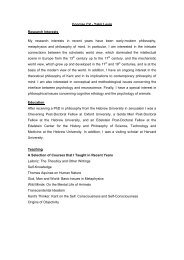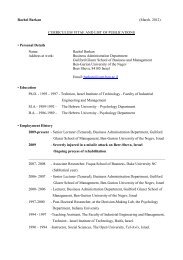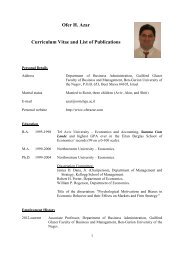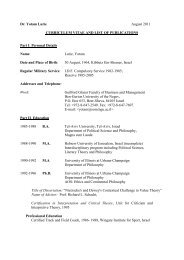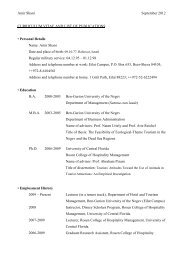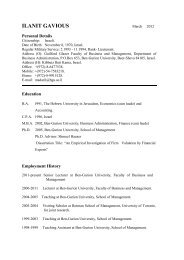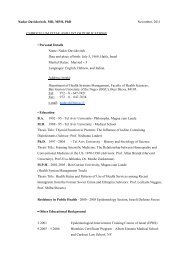cover 2006
cover 2006
cover 2006
Create successful ePaper yourself
Turn your PDF publications into a flip-book with our unique Google optimized e-Paper software.
of the basic element in water<br />
treatment – the membranes that do<br />
the actual work in filtering out<br />
impurities.<br />
“The membranes we use now are<br />
far more efficient than earlier<br />
versions,” Kasher says. “They have<br />
good flux – water flows through<br />
while salt doesn’t.We’ve also made<br />
great strides in the engineering<br />
aspects of reverse osmosis – how<br />
much pressure to apply, how much<br />
efficiency to expect. But up to now,<br />
we’ve neglected the chemistry. We<br />
don’t really understand how the<br />
membrane itself works. Of course,<br />
over the years, many different kinds<br />
of membranes have been tested and<br />
some are better than others.But we<br />
haven’t studied how they work.<br />
More importantly, we haven’t<br />
studied how they could be<br />
chemically designed to make them<br />
better.”<br />
Kasher describes the RO<br />
membrane as a three-layer ply: the<br />
working component is the “thin<br />
film” which lies next to the salt<br />
water; under that is a thicker layer<br />
of porous material, then a stiff layer<br />
for stability. “If we understood the<br />
chemistry of the process, we could<br />
design more efficient membranes,”<br />
he explains.<br />
One current problem is with<br />
bacteria.”Bacteria collect on the<br />
surface of the thin membrane,”<br />
Kasher says. “As the bacteria layer<br />
builds up, it clogs the membrane,<br />
so gradually the membrane<br />
becomes less permeable. Removing<br />
the bacteria is costly, for several<br />
reasons. First, the unit is taken out<br />
of operation; second, it’s treated<br />
with a chemical, often chlorine,<br />
which might pose problems of its<br />
own, such as generation of<br />
carcinogenic agents from organic<br />
substances. Repeated cleaning also<br />
shortens the life of the membrane,<br />
so it has to be replaced. Beyond all<br />
that, labor costs are considerable.<br />
“A specifically designed antimicrobial<br />
peptide, which could bind<br />
with the thin film, would represent<br />
a serious breakthrough. What if<br />
peptides could modify the surface<br />
of the membrane so that it would –<br />
by itself – prevent the growth of<br />
bacteria? If an anti-microbial peptide<br />
could target and kill the bacteria<br />
before they built up, that would<br />
represent a significant advance in<br />
cost control.”<br />
All of Kasher’s previous work<br />
with peptides will come into play<br />
on this new project, in which he and<br />
a team of experienced researchers<br />
will work on developing more<br />
efficient membranes. “This is an<br />
opportunity to take a big leap<br />
forward in desalination technology,”<br />
he says. “It’s an exciting project –<br />
not just for Israel, but for every<br />
thirsty country in the world.”<br />
BGU NOW 41



